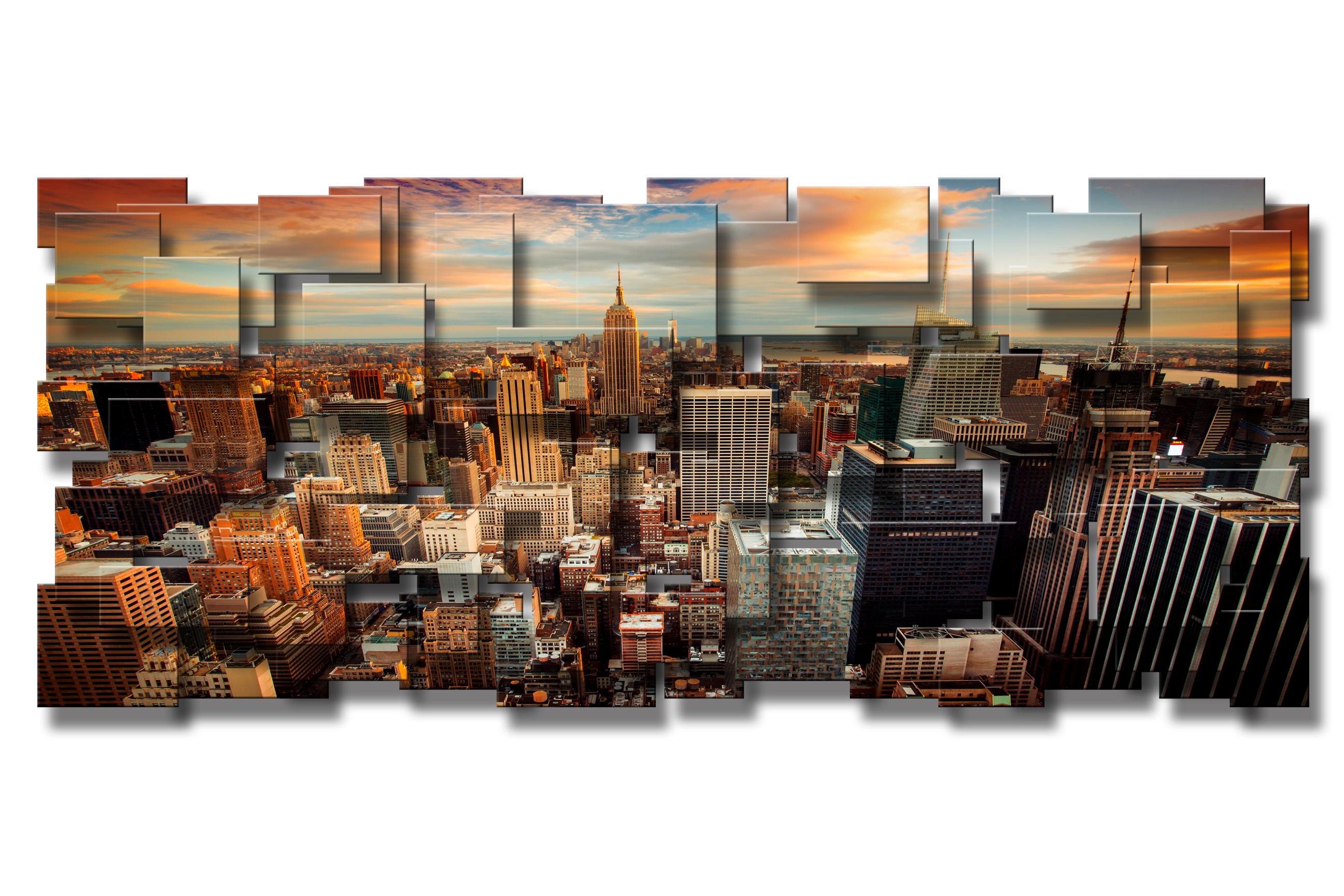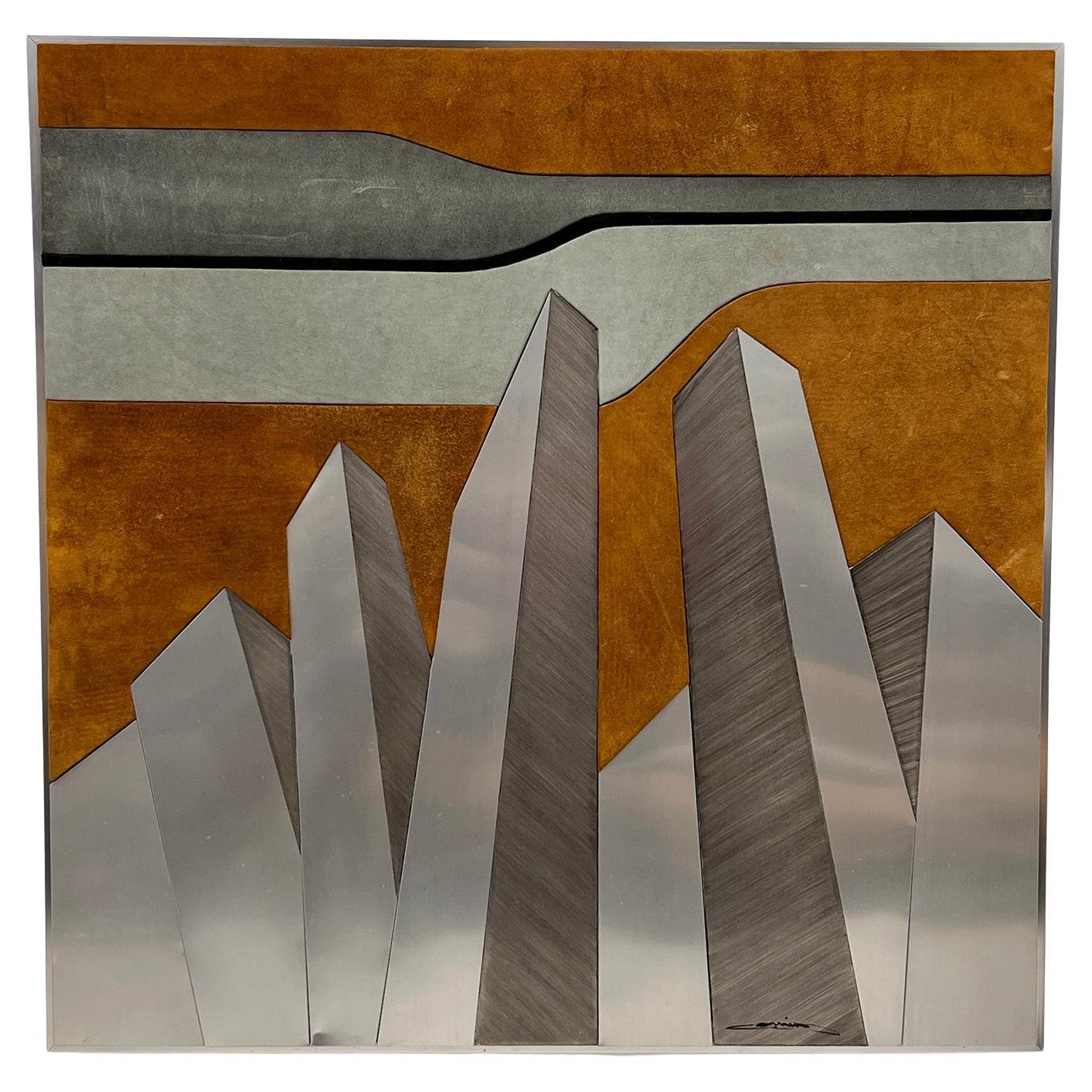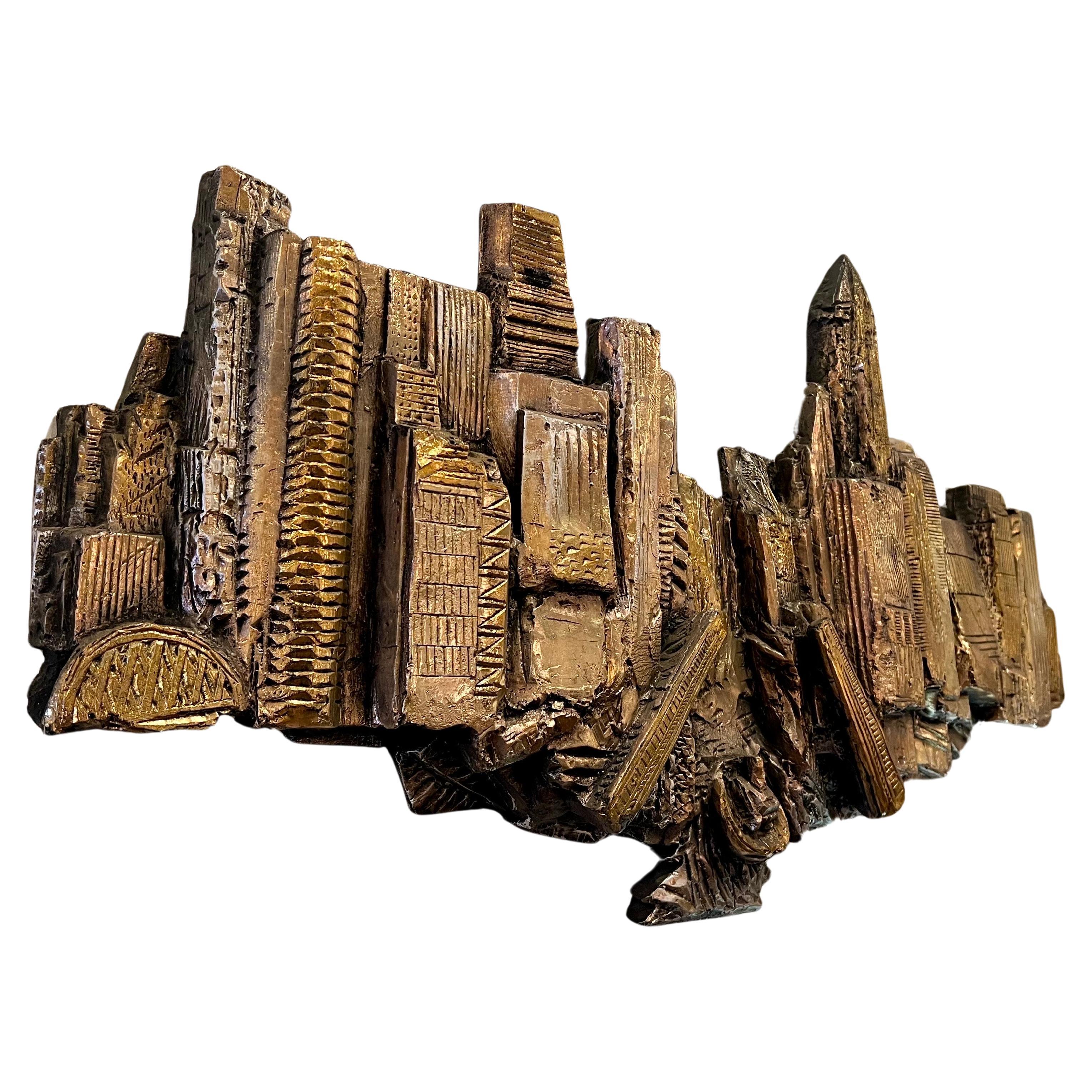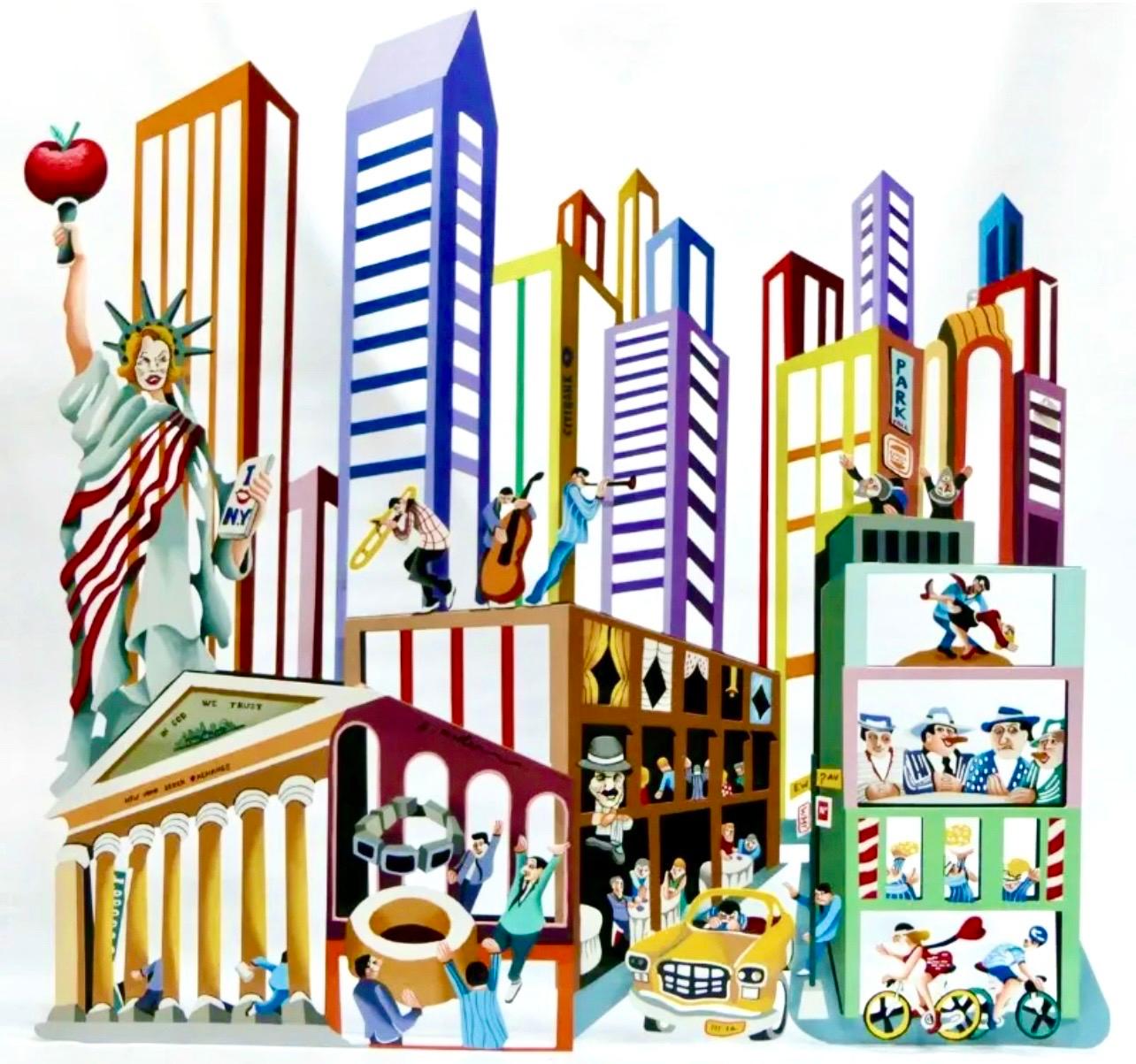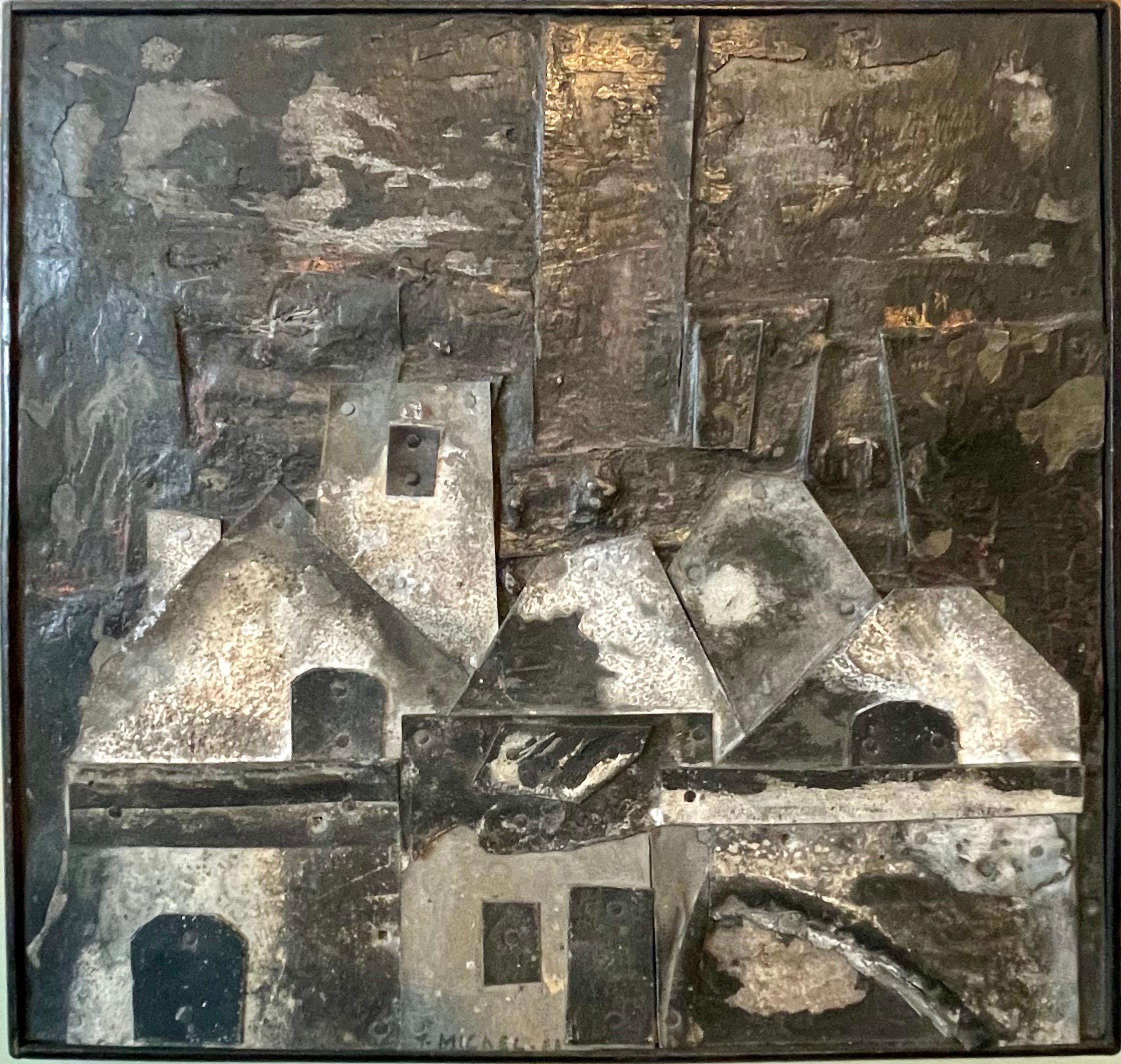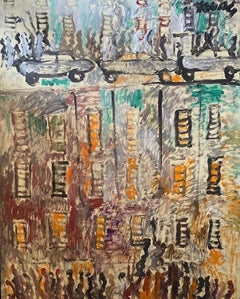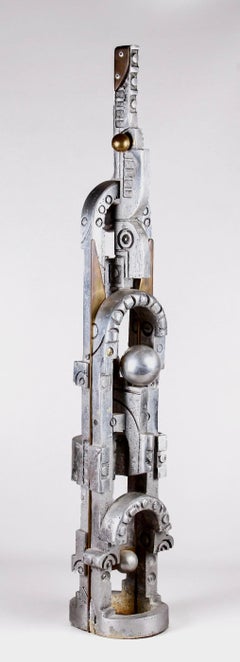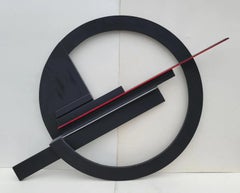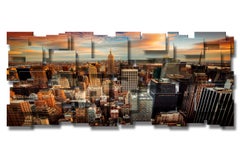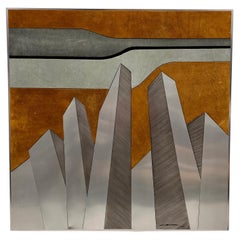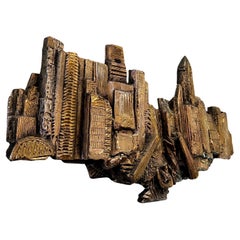Items Similar to Folk Outsider Naive Art Metal NYC Cityscape Sculpture Wall Hanging Contemporary
Want more images or videos?
Request additional images or videos from the seller
1 of 8
UnknownFolk Outsider Naive Art Metal NYC Cityscape Sculpture Wall Hanging Contemporaryc. 1990
c. 1990
$3,800
£2,883.35
€3,296.86
CA$5,307.57
A$5,901.30
CHF 3,081.33
MX$71,833.13
NOK 39,316.44
SEK 36,837.62
DKK 24,605.04
Shipping
Retrieving quote...The 1stDibs Promise:
Authenticity Guarantee,
Money-Back Guarantee,
24-Hour Cancellation
About the Item
Folk Outsider Naive Art Metal NYC Cityscape Sculpture Wall Hanging Contemporary
"NYC Cityscape"
39 1/2 x 29 1/2 x 2 inches
Unsigned
Offered is an extraordinary hand crafted wall sculpture of New York City. The work is unsigned and not dated, but it's a stunning example of outsider art.
- Creation Year:c. 1990
- Dimensions:Height: 40 in (101.6 cm)Width: 30 in (76.2 cm)Depth: 2 in (5.08 cm)
- Medium:
- Movement & Style:
- Period:
- Condition:
- Gallery Location:New York, NY
- Reference Number:1stDibs: LU1156214930712
About the Seller
5.0
Gold Seller
Premium sellers maintaining a 4.3+ rating and 24-hour response times
Established in 2008
1stDibs seller since 2019
193 sales on 1stDibs
Typical response time: <1 hour
- ShippingRetrieving quote...Shipping from: Pawling, NY
- Return Policy
Authenticity Guarantee
In the unlikely event there’s an issue with an item’s authenticity, contact us within 1 year for a full refund. DetailsMoney-Back Guarantee
If your item is not as described, is damaged in transit, or does not arrive, contact us within 7 days for a full refund. Details24-Hour Cancellation
You have a 24-hour grace period in which to reconsider your purchase, with no questions asked.Vetted Professional Sellers
Our world-class sellers must adhere to strict standards for service and quality, maintaining the integrity of our listings.Price-Match Guarantee
If you find that a seller listed the same item for a lower price elsewhere, we’ll match it.Trusted Global Delivery
Our best-in-class carrier network provides specialized shipping options worldwide, including custom delivery.More From This Seller
View All"Cars, Buildings People" Contemporary Outsider Folk Art African American Urban
By Purvis Young
Located in New York, NY
"Cars, Buildings People" Contemporary Outsider Folk Art African American Urban
The painting measures 65 x 48 inches. We love that in the middle of ...
Category
1990s Outsider Art Landscape Paintings
Materials
Masonite, Oil
Brutalist Aluminum Brass Contemporary Totem Sculpture Abstract non objective
Located in New York, NY
Brutalist Aluminum Brass Contemporary Totem Sculpture Abstract non objective
The work has a sensational presence and look great to the ey...
Category
21st Century and Contemporary Abstract Abstract Sculptures
Materials
Metal, Brass
"Abstract Cityscape" NYC Early 20th Century American Scene Social Realism Ashcan
By Abraham Walkowitz
Located in New York, NY
"Abstract Cityscape" NYC Early 20th Century American Scene Social Realism Ashcan
Abraham Walkowitz (American, 1878-1965)
Abstract Cityscape
Sight: 6 1/4' x 8 1/2 inches
Mixed media...
Category
1910s Abstract Landscape Drawings and Watercolors
Materials
Paper, Mixed Media
"Construction 1982" Abstract Wall Sculpture Contemporary Mid 20th Century Modern
By Seymour Fogel
Located in New York, NY
"Construction 1982" Abstract Wall Sculpture Contemporary Mid 20th Century Modern
Painted wood assemblage, 36 x 45 x 4 inches overall. Note the label states 3 foot diameter referring to circular portion. Exhibited, Seymour Fogel Constructions Paintings and Drawing, 1984, typed on Graham Modern label verso
Seymour Fogel was born in New York City on August 24, 1911. He studied at the Art Students League and at the National Academy of Design under George Bridgeman and Leon Kroll. When his formal studies were concluded in the early 1930s he served as an assistant to Diego Rivera who was then at work on his controversial Rockefeller Center mural. It was from Rivera that he learned the art of mural painting.
Fogel was awarded several mural commissions during the 1930s by both the Works Progress Administration (WPA) and the Treasury Section of Fine Arts, among them his earliest murals at the Abraham Lincoln High School in Brooklyn, New York in 1936, a mural in the WPA Building at the 1939-1940 New York World's Fair, a highly controversial mural at the U.S. Post Office in Safford, Arizona (due to his focus on Apache culture) in 1941 and two murals in what was then the Social Security Building in Washington, D.C., also in 1941. Fogel's artistic circle at this time included Phillip Guston, Ben Shahn, Franz Kline, Rockwell Kent and Willem de Kooning.
In 1946 Fogel accepted a teaching position at the University of Texas at Austin and became one of the founding artists of the Texas Modernist Movement. At this time he began to devote himself solely to abstract, non-representational art and executed what many consider to be the very first abstract mural in the State of Texas at the American National Bank in Austin in 1953. He pioneered the use of Ethyl Silicate as a mural medium. Other murals and public works of art done during this time (the late 1940s and 1950s) include the Baptist Student Center at the University of Texas (1949), the Petroleum Club in Houston (1951) and the First Christian Church, also in Houston (1956), whose innovative use of stained glass panels incorporated into the mural won Fogel a Silver Medal from the Architectural League of New York in 1958.
Fogel relocated to the Connecticut-New York area in 1959. He continued the Abstract Expressionism he had begun exploring in Texas, and began experimenting with various texturing media for his paintings, the most enduring of which was sand. In 1966 he was awarded a mural at the U.S. Federal Building in Fort Worth, Texas. The work, entitled "The Challenge of Space", was a milestone in his artistic career and ushered in what has been termed the Transcendental/Atavistic period of his art, a style he pursued up to his death in 1984. Painted and raw wood sculpture...
Category
1980s Assemblage Abstract Sculptures
Materials
Wood
NYC Cityscape American Scene Social Realism Mid-Century
By Max Arthur Cohn
Located in New York, NY
NYC Cityscape American Scene Social Realism Mid-Century
Max Arthur Cohn (1903-1998)
New York City Skyline
14 x 21 1/2 inches
Watercolor on paper, c. 1...
Category
1930s American Modern Figurative Drawings and Watercolors
Materials
Paper, Watercolor
Bridge Contemporary African American Urban Landscape 20th Century Alvin Ailey NY
By Romare Bearden
Located in New York, NY
"Bridge" Contemporary African American Urban Landscape 20th Century Alvin Ailey NYC
ROMARE BEARDEN (American, 1914-1988)
The Bridge, 1982
signed 'Romare Bearden' (upper left); with...
Category
1980s Contemporary Landscape Drawings and Watercolors
Materials
Watercolor, Paper
You May Also Like
Empire, Urban Abstract Original Metal Wall Sculpture, Modern Art, One of a Kind
Located in Granada Hills, CA
Urban Abstract Original Metal Wall Sculpture, Modern Art, One of a Kind
Artist: Karo Martirosyan,
Work: Original Artwork,
Medium: Glass and Metal Wall Sculpture,
Year: 2022
St...
Category
2010s Modern Abstract Sculptures
Materials
Metal
Mid Century Modern Mixed Media Large Scale Cityscape Artwork in Suede and Steel
Located in Culver City, CA
If Gotham City and a Pierre Cardin fever dream had a love child, it would be this stunning 1970s mixed media artwork. At a striking 48.5 x 48.5 inches, this piece is big, bold, and b...
Category
Vintage 1970s Mid-Century Modern Contemporary Art
Materials
Steel
$1,680 Sale Price
20% Off
Empire, City Abstract 3D Original Metal Wall Sculpture, modern design
Located in Granada Hills, CA
Artist: Karo Martirosyan,
Work: Original Artwork,
Medium: Glass and Metal Wall Sculpture,
Year: 2024
Style: Contemporary Art,
Subject: Empire,
Size: 30" x 72" x 4'' inch, 76x...
Category
2010s Modern Abstract Sculptures
Materials
Metal
Brutalist Cityscape Modernist Fiberglass Wall Relief 3D Sculpture
By Finesse Originals
Located in San Diego, CA
Rare fiberglass resin wall art cityscape, in a gold and black finish , very rare and unique piece.
Category
20th Century American Mid-Century Modern Wall-mounted Sculptures
Materials
Resin
Large Metal Sculpture Wall Hanging 3D Painting New York City Whimsical Pop Art
By Yuval Mahler
Located in Surfside, FL
Large painted metal wall hanging sculpture by Yuval Mahler (Israeli, b. 1951). Hand signed "Y. Mahler" recto. (it is not numbered or editioned and might be unique). it is done in a g...
Category
21st Century and Contemporary Pop Art Figurative Paintings
Materials
Metal
French Outsider Art Brut Mixed Media Zinc Assemblage Sculpture Collage Painting
Located in Surfside, FL
Mixed media assemblage sculpture/painting. Hand signed and dated recto and verso.
Provenance: Galerie Alphonse Chave, bears their label verso
Michel, Fernand (1913-1999)
Born in 1913 in Neuviller-lès-Badonviller in the Vosges, Fernand Michel began working at the age of twelve in a Landes pottery factory. When his mother died, he went to live in Alsace with an aunt and became an art bookbinder. A lover of poetry, he bonded with Jean Vodaine, Jean Dubuffet and Alphonse Chave (Alphonse Chave was an art lover, dealer and collector. On November 15, 1947 in Vence, under the name Les Mages, he opened a contemporary art gallery which would also become a high place of art brut and unique art . The gallery took its final name - Galerie Alphonse Chave - in 1960. He exhibited Dado, Philippe Dereux, Jean Dubuffet, Max Ernst, Henri michaux, Louis Pons, Man Ray, Dorothea Tanning, Zao Wou-ki as well as other creators.)
Around 1962, he began carving zinc after finding a plaque in a landfill. From this period, he made numerous assemblies, most often of large dimensions, which he called "zinc works" where buxom bathers, Venus callipyges, nuns and holy nitouches rub shoulders. The corroded and battered material over the years, used as is, gives his works a certain harshness, however softened by more ornamental pieces. Fernand Michel lived in Montpellier. He died in 1999. His work is present in the collection of La Fabuloserie in Dicy.
Publications
Revue "Création Franche" N ° 16, November 1998
Catalog "Donation Claude Massé", March 1999
Catalog "Collection Création Franche - 1989-2010", September 2010
Revue "Création Franche" N ° 38, June 2013
Franche Creation, Special Issue N ° 2, April 2015
His son Patrick Michel's collection is housed in Montpellier in the Musee d’arts brut, singulier and autres. "I used to accompany my father to his exhibitions since he was exhibited every year at the Galerie Chave in Vence. I still remember that Alphonse Chave once offered me a little toy (a car!) from his shop. I therefore met the artists Philippe Dereux, Armand Avril, François Ozenda, Pascal Verbena, Louis Pons, Jean Vodaine, Henri Comby, Fred Deux and Eugène Gabritschevsky- I took the decision to create the museum in order to save (and protect) my father’s work- my father was often classified under the ‘Art Brut’ label but in fact he belonged to the ‘Singular Art’ label...
The term Art Brut exists since Jean Dubuffet gave it to us in 1945, covering self-taught and marginalised artists..The terms Outsider Art and Art Brut are fine with me- I place Nek Chand before Le Facteur Cheval. I also like the Art Brut artists Augustin Lesage...
Category
1960s Outsider Art Mixed Media
Materials
Metal
More Ways To Browse
Retro Metal Art
Hanging Metal Wall Sculpture
Prada 2006 Re Edition
Sonia Pacheco
Sweet Dog Nara
Symphonic Record Player Vintage Record Players
Symphonic Record Player
Yuki Matsueda
Abmeyer Wood Fine Art
Albert Paley Menorah
Bearbrick Emotionally Unavailable
Cai Zhisong
Chris Bakay
Friday Jibu
Karl Lagasse
Kjell Janson
Mschf Blur
Pekka Paikkari
